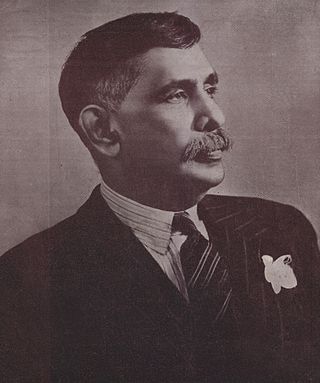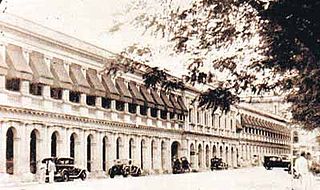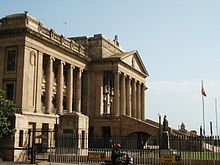
The Parliament of the Democratic Socialist Republic of Sri Lanka is the supreme legislative body of Sri Lanka. It alone possesses legislative supremacy and thereby ultimate power over all other political bodies in the island. It is modeled after the British Parliament.

Don Stephen Senanayake was a Ceylonese statesman. He was the first Prime Minister of Ceylon having emerged as the leader of the Sri Lankan independence movement that led to the establishment of self-rule in Ceylon. He is considered as the "Father of the Nation".

The governor-general of Ceylon was the representative of the Ceylonese monarch in the Dominion of Ceylon from the country's independence in 1948 until it became the republic of Sri Lanka in 1972.

Sir Oliver Ernest Goonetilleke was a Sri Lankan statesman. Having served as an important figure in the gradual independence of Ceylon from Britain, he became the third Governor-General of Ceylon (1954–1962). He was the first Ceylonese individual to hold the vice-regal post.
The Donoughmore Commission (DC) was responsible for the creation of the Donoughmore Constitution in effect between 1931 and 1947 in Ceylon. In 1931 there were approximately 12% Ceylonese Tamils, 12% Indian Tamils, 65% Sinhalese, and ~3% Ceylon Moors. The British government had introduced a form of communal representation which a strong Tamil representation, out of proportion to the population of the Tamil community. The Sinhalese had been divided into up-country and low-country Sinhalese.

The Constitution of the Democratic Socialist Republic of Sri Lanka has been the constitution of the island nation of Sri Lanka since its original promulgation by the National State Assembly on 7 September 1978. As of October 2022 it has been formally amended 21 times.
The Ceylon Civil Service, popularly known by its acronym CCS, was the premier civil service of the Government of Ceylon under British colonial rule and in the immediate post-independence period. Established in 1833, it functioned as part of the executive administration of the country to various degrees until Ceylon gained self-rule in 1948. Until it was abolished on 1 May 1963 it functioned as the permanent bureaucracy or secretariat of Crown employees that assisted the Government of Ceylon.

The Speaker of the Parliament of the Democratic Socialist Republic of Sri Lanka is the presiding officer of the chamber. The current Speaker of the Parliament is Mahinda Yapa Abeywardena, in office since 20 August 2020. The Speaker fulfills a number of important functions in relation to the operation of the House, which is based upon the British Westminster parliamentary system.
The Soulbury Commission, announced in 1944 was, like its predecessor, the Donoughmore Commission, a prime instrument of constitutional reform in British Ceylon. The immediate basis for the appointment of a commission for constitutional reforms was the 1944 draft constitution of the Board of Ministers, headed by D.S. Senanayake. This commission ushered in Dominion status and Independence to Sri Lanka in 1948. Its constitutional recommendations were largely those of the 1944 Board of Ministers' draft, a document reflecting the influence of Senanayake and his main advisor, Sir Ivor Jennings.

The Legislative Council of Ceylon was the legislative body of Ceylon established in 1833, along with the Executive Council of Ceylon, on the recommendations of the Colebrooke-Cameron Commission. It was the first form of representative government in the island. The 1931 Donoughmore Constitution replaced the Legislative Council with the State Council of Ceylon.

Sir Susantha de Fonseka KBE was a Ceylonese statesman and diplomat. He was the Deputy Speaker of the State Council of Ceylon and following Ceylon's independence from Britain his first Ambassador to Burma and first Ambassador to Japan. De Fonseka took an active part in the country's struggle for universal suffrage and self-determination.

The British Ceylon period is the history of Sri Lanka between 1815 and 1948. It follows the fall of the Kandyan Kingdom into the hands of the British Empire. It ended over 2300 years of Sinhalese monarchy rule on the island. The British rule on the island lasted until 1948 when the country regained independence following the Sri Lankan independence movement.

George Edmund de Silva was a Ceylonese lawyer and politician. He was the first Cabinet Minister of Industries, Industrial Research and Fisheries in independent Sri Lanka (1947–1948), a Member of Parliament and State Council.
Sir Don Henry Kotelawala was a Ceylonese politician. He was an elected member of the Legislative Council of Ceylon and State Council of Ceylon from the Uva and Badulla for 28 years.
Gate Mudaliyar Arachchige Don Pantalion Jayasuriya was a Ceylonese politician.
Hector de Zoysa Siriwardena, CBE was a Ceylonese politician.

George Reginald de Silva was a Ceylonese politician.

Dewan Bahadur Chevalier Ignatius Xavier Pereira was a colonial-era Ceylonese businessman and politician.
The Legal Secretary of Ceylon, was an officer of state of the British Colonial Administration of Ceylon from 1931 to 1947, appointed from the Colonial Legal Service. The Legal Secretary one of three officers of state of the Board of Ministers of the State Council of Ceylon, who serve as the legal advisor to the government; administration of justice; criminal prosecutions and civil proceeding on behalf of the crown; election to the State Council, drafting of legislature and the public trustee. The post was formed under recommendations of the Donoughmore Commission the post replaced the Attorney General as the chief legal advisor to the Governor, it was in turn replaced by the post of Minister of Justice in 1947 under the recommendations of the Soulbury Commission under the Ceylon Independence Act, 1947 and The Ceylon Orders in Council 1947.
The Financial Secretary of Ceylon was an officer of the Ceylonese Government and member of the Board of Ministers. The Treasurer of Ceylon was one of six offices that held a seat in the Executive Council of Ceylon from 1809 to 1932. The post was replaced by the that of Financial Secretary in 1932, as one of three officers of state of the new Board of Ministers that replaced the Executive Council under recommendations of the Donoughmore Commission. The Financial Secretary was in turn replaced by the new office of the Minister of Finance in 1947 under the recommendations of the Soulbury Commission under the Ceylon Independence Act, 1947 and The Ceylon Orders in Council 1947.














